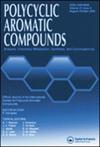Valeramide and Halo-phenol in a Non-polar Liquid: DFT Based Characterization and Reactivity, Non-covalent Interaction, and Dielectric Relaxation Studies
IF 2.6
3区 化学
Q2 CHEMISTRY, ORGANIC
引用次数: 0
Abstract
Valeramide and halogenated phenol in solvent benzene have been studied using DFT. Dielectric relaxation studies have also been undertaken. The wave functional characteristics like reduced density gradient (RDG), electron localization function (ELF), localized orbital locator (LOL) are also evaluated. It has been found that the computed FMO energies accurately depict the characteristics of electron excitation which provide an explanation for the charge transfer. MEP analysis is done to identify electrophilic and nucleophilic sites. The theoretical analysis of the UV-Visible spectrum using the TD-DFT method in solution and the computational investigation of spectroscopic wavenumbers was also carried out (IR, Raman). Thermodynamic properties of title compound at different temperatures was carried out. Various dielectric parameters, like the dielectric constant the dielectric loss at microwave frequency, the static dielectric constant ε0 and the dielectric constant ε∞ at optical frequency, were measured across five distinct molar ratios (i.e. 1:3, 1:2, 1:1, 2:1 and 3:1). While the relaxation time τ2 for group rotation is utilized to identify the steric interaction of the proton donor, Higasi’s single-frequency equation is proven to measure multiple relaxation time τ1 to determine the intensity of hydrogen bonding. At a 1:1 (molar ratio), the values of relaxation time were found to be high. Molecular docking was done in a supplementary effort to support intermolecular interactions.
非极性液体中的缬草酰胺和卤代酚:基于DFT的表征和反应性、非共价相互作用和介电弛豫研究
用离散傅里叶变换法研究了戊酰胺和卤代酚在溶剂苯中的反应。还进行了介电松弛研究。并评价了还原密度梯度(RDG)、电子局域化函数(ELF)、局域化轨道定位器(LOL)等波函数特征。计算得到的FMO能量准确地描述了电子激发的特征,为电荷转移提供了解释。MEP分析是用来确定亲电和亲核位点的。利用溶液中的TD-DFT方法对紫外-可见光谱进行了理论分析,并对光谱波数进行了计算研究(IR, Raman)。研究了标题化合物在不同温度下的热力学性质。在五种不同的摩尔比(即1:3、1:2、1:1、2:1和3:1)下,测量了微波频率下的介电常数ε′、介电损耗ε″、静态介电常数ε0和光学频率下的介电常数ε∞等介电参数。而基团旋转的弛豫时间τ2被用来识别质子供体的空间相互作用,Higasi的单频方程被证明可以测量多重弛豫时间τ1来确定氢键的强度。当摩尔比为1:1时,弛豫时间值较高。分子对接是支持分子间相互作用的补充工作。
本文章由计算机程序翻译,如有差异,请以英文原文为准。
求助全文
约1分钟内获得全文
求助全文
来源期刊

Polycyclic Aromatic Compounds
化学-有机化学
CiteScore
3.70
自引率
20.80%
发文量
412
审稿时长
3 months
期刊介绍:
The purpose of Polycyclic Aromatic Compounds is to provide an international and interdisciplinary forum for all aspects of research related to polycyclic aromatic compounds (PAC). Topics range from fundamental research in chemistry (including synthetic and theoretical chemistry) and physics (including astrophysics), as well as thermodynamics, spectroscopy, analytical methods, and biology to applied studies in environmental science, biochemistry, toxicology, and industry. Polycyclic Aromatic Compounds has an outstanding Editorial Board and offers a rapid and efficient peer review process, as well as a flexible open access policy.
 求助内容:
求助内容: 应助结果提醒方式:
应助结果提醒方式:


